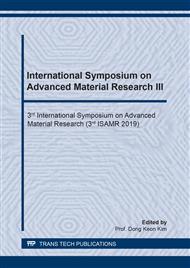p.20
p.27
p.33
p.39
p.47
p.53
p.59
p.64
p.70
Energy-Absorption Ability of Embedding Whisker Alumina Fiber into Natural Rubber Composite for Insulation Applications
Abstract:
Natural rubber is an elastomeric material to make rubber products such as toys, households, automobiles, wheel tires, medical and health care products. Natural rubber compound is one kind of polymer matrix composites (PMCs) composed of natural rubber compound acted as a matrix phase and filler acted as a dispersed or reinforcement phase. There are many kinds of fillers used in the PMCs in terms of particles, fibers, and structural sheets. Adding organic/inorganic fibers into the natural rubber composites can increase the mechanical-thermal-physical properties and sound absorption. The natural rubber embedded fiber composite samples were prepared via the vulcanization process at the curing temperature 150°C by the two-roll mill. The amount of whisker alumina (Al2O3), coconut coir and water hyacinth fiber were varied from 0 to 50 phr on 100 phr of natural rubber in a sulfur curing system. The obtained rubber composite samples were of good mechanical properties, low thermal conductivity and good acoustic-sound absorption, suitable for various applications such as automobile, insulation and storage tank. The obtained rubber composite with 10 phr whisker alumina added (NR-Al-10) possessed the tensile strength, Young’s modulus, elongation at break and thermal conductivity values equal to 14.38 ± 1.95 MPa, 545.63 ± 25.67 MPa, 1038.4 ± 41.45% and 0.02527 ± 0.0003 W/m.K, respectively. Furthermore, the sound absorption value of natural rubber composite added 10 phr whisker alumina (NR-Al-10) is equal to 45.09% in the range of 3000‒4000 Hz of acoustic sound level better than the pure natural compound without adding filler.
Info:
Periodical:
Pages:
47-52
Citation:
Online since:
April 2020
Price:
Сopyright:
© 2020 Trans Tech Publications Ltd. All Rights Reserved
Share:
Citation:


